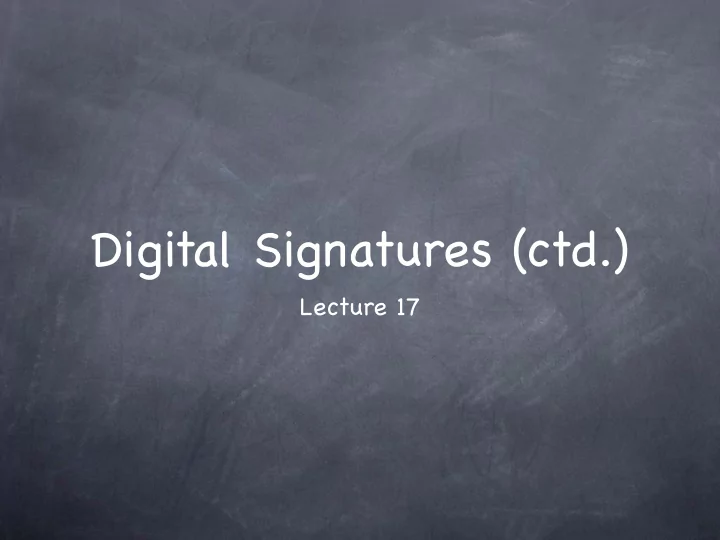

Digital Signatures (ctd.) Lecture 17
RECALL Digital Signatures Syntax: KeyGen, Sign SK and Verify VK . Security: Same experiment as MAC’ s, but adversary given VK Sig SK Ver VK s i = Sign SK (M i ) Ver VK (M,s) (M,s) M i VK Advantage = Pr[ Ver VK (M,s)=1 and (M,s) ∉ {(M i ,s i )} ] Weaker variant: Advantage = Pr[ Ver VK (M,s)=1 and M ∉ {M i } ]
Digital Signatures Online verification of real life identity is difficult But the verification key for a digital signature can serve as your digital identity OK to own multiple digital identities Compromised if you lose your signing key Central to identity on the internet (with the help of certificate authorities), crypto currencies, etc.
Signatures from OWF Lamport’ s scheme based on OWF One-time and has a fixed-length message One-time, fixed-length message signatures (Lamport) Domain-Extension → arbitrary length messages (using UOWHF) “Certificate Tree” → many-time signatures (using PRF) So full-fledged digital signatures can be entirely based on OWF Last time: Hash-and-Sign domain extension for signatures Domain extension can be done using CRHF (more efficient) or UOWHF (more secure) Today: “Certificate tree”
One-Time → Many-Times Certificate chain: VK 1 → (VK 2 , σ 2 ) → … → (VK t , σ t ) → (m, σ ) where σ i is a signature on VK i that verifies w.r.t. VK i-1 Suppose a “trustworthy” signer only signs the verification key of another “trustworthy” signer. Then, if VK 1 is known to be issued by a trustworthy signer, and all links verified, then the message is signed by a trustworthy signer. Certificate tree for one-time → many-times signatures Idea: Each message is signed using a unique VK for that message Verifier can’ t hold all VKs: A binary tree of VKs, with each leaf designated for a message. Parent VK signs its pair of children VKs (one-time, fixed-length sign). Verifier remembers only root VK. Signer provides a certificate chain to the leaf VK used. Signer can’ t remember all SKs: Uses a PRF to define the tree (i.e., SK for each node), and remembers only the PRF seed
Domain Extension of RECALL Signatures using Hash Domain extension using a CRHF (not weak CRHF , unlike for MAC) Sign* SK,h (M) = Sign SK (h(M)) where h ← H in both SK*,VK* Security: Forgery gives either a hash collision or a forgery for the original (finite domain) signature Formal reduction to a pair of adversaries. Hash adversary sends h it receives as part of VK Can use UOWHF , with fresh h every time (included in signature) Sign* SK (M) = ( h,Sign SK (h,h(M)) ) where h ← H picked by signer Security: To use a signature s i in forgery, need M such that h(M)=h(M i ). But h is picked by signing algorithm after M i is submitted. Breaks UOWHF security by finding such a collision. In reduction, hash adversary guesses an i where collision occurs and sends h it received as part of signature
RECALL More Efficient Signatures: Hash and Invert Using a trapdoor OWP and a “hash”: Sign(M) = f -1 ( Hash(M) ) Where (SK,VK) = (f -1 ,f), a Trapdoor OWP pair Secure in the random oracle model Hash can handle variable length inputs “Standard schemes” like RSA-PSS are based on this
Schnorr Signature Public parameters: (G,g) where G is a prime-order group and g a generator, for which DLA holds, and a random oracle H Or (G,g) can be picked as part of key generation Signing Key: y ∈ Z q where G is of order q. Verification Key: Y = g y Sign y (M) = (x,s) where x = H(M||g r ) and s = r-xy, for a random r Verify Y (M,(x,s)): Compute R = g s ⋅ Y x and check x = H(M||R) Secure in the Random Oracle model under the Discrete Log Assumption for a group Alternately, under a heuristic model for the group (called the Generic Group Model), but under standard-model assumptions on the hash function
VK as ID: An Example Identity-Based Encryption In PKE, KeyGen produces a random (PK,SK) pair Can I have a “fancy public-key” (e.g., my name)? No! Not secure if one can pick any PK and find an SK for it! But suppose a trusted authority for key generation Then: Can it generate a valid (PK,SK) pair for any PK? Identity-Based Encryption: a key-server (with a master secret-key) that can generate such pairs Encryption will use the master public-key, and the receiver’ s “identity” (i.e., fancy public-key) In PKE, sender has to retrieve PK for every party it wants to talk to (from a trusted public directory) In IBE, receiver has to obtain its SK from the authority
VK as ID: An Example Identity-Based Encryption Security requirement for IBE (will skip formal statement): Environment/adversary decides the ID of the honest parties Adversary can adaptively request SK for any number of IDs (which are not used for honest parties) “Semantic security” for encryption with the ID of honest parties (i.e., with no access to decryption: CPA security) IBE (even CPA-secure) can easily give CCA-secure PKE! IBE: Can’ t malleate ciphertext for one ID into one for another PKEnc MPK (m) = (id, C=IBEnc MPK (id; m), sign id (C) ) Security: can’ t create a different encryption with same id (signature’ s security); can’ t Digital Signature with malleate using a different id (IBE’ s security) its public-key used as the ID in IBE
Recommend
More recommend